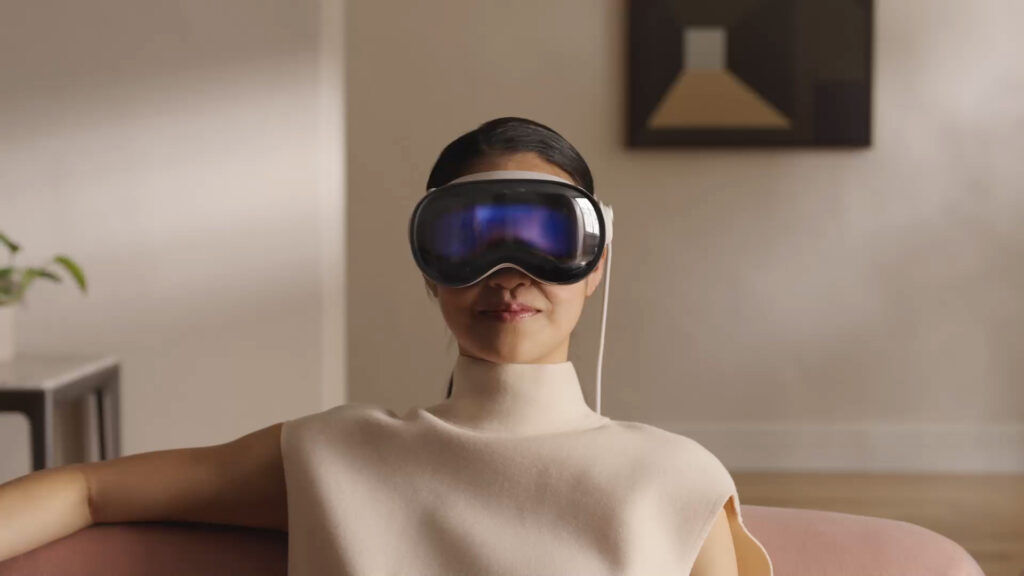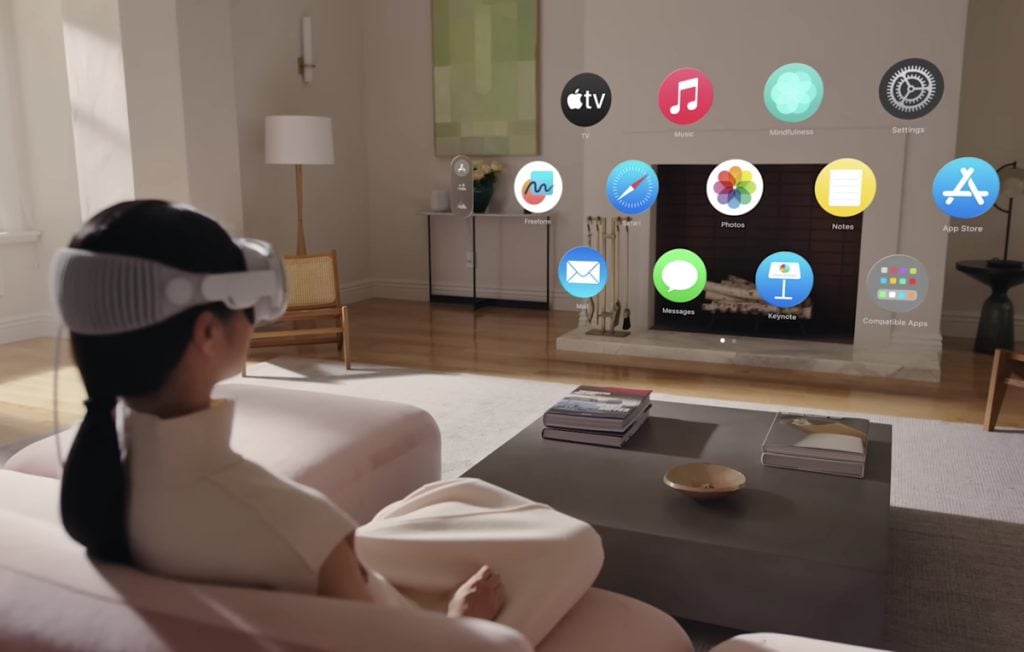
What is the Apple Vision Pro?
Apple’s Vision Pro headset is an advanced Immersive Reality (XR) headset that sets itself apart in the realm of similar devices. This headset will allow users to blend digital visuals and audio with their actual surroundings, providing a rich and immersive experience.
Key Features of the Apple VisionPro:
- Spatial Integration: One of the standout features of the VisionPro is its ability to merge digital content smoothly with the physical environment.
- Display Quality: With dual micro-OLED displays offering a resolution of 2048×2048 per eye, the VisionPro sets a high benchmark. Compared to many XR headsets in its class, which generally hover around 1080×1200 resolution, the Vision Pro will provide a notably crisper and more detailed visual output.
- LiDAR Scanner Functionality: The inclusion of a LiDAR scanner takes positional tracking to the next level. The scanner’s accuracy in capturing user movements in 3D space significantly boosts the immersive quality of XR experiences.
- Customisation & Comfort: The ability to personalise fittings, particularly the option for prescription lens inserts, is unique to XR headsets and caters to a broader audience with varying visual needs.
- Digital Identity Features: The facial scanning capability, which aids in creating unique digital avatars, is a novel touch. It’s an added layer of personalisation, albeit one that might appeal more to some users than others.
- Performance & Compatibility: Powered by the Apple M2 chip, it’s among the top-tier in terms of processing capability and offers great compatibility potential with the Apple ecosystem.

What makes it different from existing XR devices?
The Apple Vision Pro sets itself apart in the burgeoning XR landscape by fundamentally reimagining the balance between Augmented Reality (AR) and Virtual Reality (VR) functionalities. While most XR devices have primarily been VR-centric with supplementary AR capabilities, Vision Pro flips the script, placing augmented reality at the forefront and offering developers and users the ability to shift between the amount of VR and AR used. This approach not only facilitates prolonged daily use, breaking from the limited immersive sessions that typical VR devices offer, but it also seamlessly merges the digital realm with users’ everyday lives. Furthermore, its integration into Apple’s ecosystem promotes unparalleled seamlessness and the promise of spatial computing—offering interfaces that emulate established Apple products—signals a significant step towards a future where our digital and physical realities aren’t just interconnected, but indistinguishable.

How could the Apple Vision Pro be transformative for Healthcare Education and Learning Technology?
In the evolving landscape of healthcare education, the focus on sustainability is paramount. Immersive technology, especially through the lens of XR, offers a pathway to craft genuine, repeatable, and entirely safe training scenarios. These advanced simulations empower healthcare professionals to refine skills and bolster decision-making competency without the inherent risks of real-world interactions. This is an expanding opportunity to delve deeper into how XR technologies can champion sustainable training methods. Specifically, the potential of XR in equipping professionals for rare, yet crucial situations, without overextending resources or jeopardizing patient well-being, underscores its invaluable role in contemporary healthcare training.
Extended Reality (XR) offers an edge over traditional training methods by providing immersive, scalable, and consistent experiences. Apple’s VisionPro, acting as a conduit for XR, eliminates the inherent limitations of physical simulation: the high costs, space requirements, and resource intensity. Instead, trainees can immerse themselves in diverse healthcare environments—from emergency room simulations to radiology suites—without ever leaving their study space. This XR-based approach not only scales up training opportunities without corresponding hikes in resources but also ensures standardised experiences across the board.
Furthermore, with systems like the VisionPro potentially offering advanced analytics, learners benefit from quantifiable feedback on their progression. The adaptability and ubiquity of XR technologies such as VisionPro can address the current gaps in learner-centered healthcare education, providing repeated and consistent training scenarios. In essence, Apple VisionPro’s capabilities, combined with XR’s proven benefits, can pave the way for a paradigm shift in healthcare education, allowing for more versatile, efficient, and effective learning experiences.
In summary, Apple’s VisionPro is not just another addition to the XR market; it represents a significant leap forward in merging our digital and physical worlds. By prioritizing AR capabilities and tapping into Apple’s integrated ecosystem, this device exemplifies what the future of immersive technology holds. Its potential influence on healthcare education is particularly promising, suggesting a future where training is not only more efficient but also deeply immersive and learner-centric. As XR technologies continue to evolve, products like the VisionPro are poised to redefine the boundaries of both personal tech and professional training.